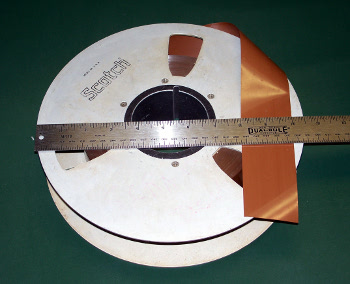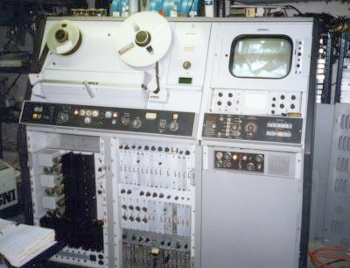Ampex
July 22, 2011
Nowadays, working with
video is extremely easy. Everything is in
digital form, and video content exists as digital streams sent to our computers through the internet, from
video discs, or from the
hard drives in our
digital video recorders. Not that long ago, video was stored in
analog form, on long pieces of
magnetic tape in bulky
VHS cassettes. These tapes were played on machines with motors and quite a few mechanical parts. I still have a closet filled with VHS tapes, and it's rare that I view any of them. The viewing process for VHS tape is very tedious compared with that for
DVDs.
Analog was the only possible method of recording
television video in the decades before ubiquitous computing. It takes a lot of computer power to
compress video signals into digital data of a lower signal rate, and it takes a lot of expensive
digital memory to store the signals. Video recording was possible using analog techniques in the days before digital, but it still took quite some time for analog video recorders, such as VHS and
Betamax, to make it into everyone's living room. The problem is that video is a
wide bandwidth signal.
Audio recorders need to reproduce rather lethargic signals, ranging from about 20
Hz to 20,000 Hz. Television video, however, requires a bandwidth of several
megahertz, and that's for the pedestrian
NTSC signals of 525 line frames at thirty
frames per second.[1] Actually it's sixty half-frames per second of even, then odd, scan lines, to eliminate
flicker. If we
pixelize this into 525 x 525 = 275,625 pixels, updated thirty times per second, and multiplying by a
Nyquist factor of two, we get 18 MHz. Broadcast television took some shortcuts, since an analog television station's bandwidth was only 6 Mhz.
To record megahertz signals on magnetic tape, you need to be mindful of the medium. Magnetic tape consists of
magnetic oxide powder bound to an
acetate or
mylar tape. You need to make sure that there's at least one magnetic particle underneath your recording head every time the video signal changes appreciably. Since these particles have a density of just a few thousand per linear inch, that means you need to move the tape past your recoding head, or your recoding head past the tape, at about a thousand inches per second.
Moving tape that fast can't be done easily, so the recording/playback head moves rapidly past a slowly moving tape in a way to pack in all that analog data. In a VHS video recorder, the head scans a
helical track on the tape. In early machines,
tracks were placed across the full width of the tape, and the tape was as much as two inches wide. When I worked in broadcast television in the late 1960s, the recorders that did this were about as large as two refrigerators, side by side. They were manufactured by a company called
Ampex.

Two-inch magnetic tape on a 10.5-inch reel, circa 1968, as used for video recording at a broadcast television station.
(Photo by author, via Wikimedia Commons).
Ampex wasn't founded as a video recorder company. In fact, its first products were specialty
electric motors, a technology that enabled a subsequent audio recorder business. Its entry into the audio recorder business came as a result of
World War II.
Jack Mullin, who served in the
US Army Signal Corps, discovered two novel
German recording technologies at Radio
Frankfurt, and he brought examples of German recording technology back to the US.
One of the technologies used in Germany was high frequency
AC biasing of the magnetic particles to reduced distortion caused by
magnetic hysteresis. The other was
Magnetophon recording, which was magnetic tape recording. Mullin demonstrated tape recording at a May 16, 1946, meeting of the
Institute of Radio Engineers.
Mullin improved the Magnetophon recorders, and he demonstrated them in 1947 to
Bing Crosby, who had a popular radio show but detested the regimen of live broadcasting. Crosby hired Mullin to be his chief engineer and placed a $50,000 order with Ampex (half a million dollars in today's money) to produce broadcast quality tape recorders. The result was the Ampex Model 200. Crosby gave one of these to his friend,
Les Paul, who modified it to make
multitrack recordings. Paul collaborated with Ampex in the design and construction of multitrack recorders.
Then, of course, there was television, which was a bigger nut to crack. Crosby migrated to television in the 1950s, and Ampex, with assistance from Mullin, developed a monochrome recorder, followed by a color recorder. Since these used
vacuum tube technology, they were huge devices, and they required the constant care of a technician. Such recorders evolved into the Ampex VR-2000 high-band videotape recorder, introduced in 1964, that I used during my college days in a summer job at a television station.

The Ampex VR-2000 high-band video recorder, introduced in 1964.
I worked with these in the late 1960s when I had a summer job at a television station during college.
(Photo via Wikimedia Commons).
One important contribution that Ampex made to recording technology was its hiring of the precocious
Ray Dolby as a part-time and summer employee while he was still a student. Dolby worked on both audio and video recorders for Ampex, and he went on to invent his
Dolby noise reduction system[2] which he sold through his own company,
Dolby Laboratories.
There's an interesting story about Crosby's interest in television recording. Crosby was part owner of the
Pittsburgh Pirates baseball team when it played in the
1960 World Series against the
New York Yankees (a series I watched in glorious monochrome on my grandparents' television set). Crosby was
superstitious to the point that he left the country during the series so he wouldn't
jinx the team.[3]
Crosby, however, wanted to see the winning game at a later time if the Pirates won. He arranged to have the final game, game seven, recorded on
film using
kinescope, a process in which a television monitor is filmed. Crosby archived the film in his
wine cellar, a perfect environment for film preservation. These reels of film, the only known complete copy of a game that's considered one of the greatest in baseball, were discovered in December, 2009.[3]
Not as fortunate are the
lost episodes of
Doctor Who that were erased in order to reuse the video tape and make room in the archives for newer shows. Copies of some episodes were discovered at remote broadcast centers, but more than a hundred episodes are lost.
References:
- An old broadcast engineer told me that NTSC stood for "Never The Same Color." It actually stands for National Television System Committee, but in its compromise standard to make color signals compatible with the older monochrome receivers, the colors weren't fixed, and they were adjustable on the home receiver. The way that this color/monochrome compatibility was done in those vacuum tube days is quite ingenious. You can read about it here.
- Ray Dolby, "Signal Compressors And Expanders," US Patent No. 3,631,365, December, 1971
- Richard Sandomir, "In Bing Crosby’s Wine Cellar, Vintage Baseball," The New York Times, September 23, 2010.
- Ampex Page on Wikipedia.
Permanent Link to this article
Linked Keywords: Video; digital; video disc; hard drive; digital video recorder; analog; magnetic tape; VHS; cassette; DVD; television; data compression; digital memory; Betamax; wide bandwidth signal; audio; hertz; Hz; megahertz; NTSC; film frame; flicker; pixel; pixelize; Nyquist; Iron(III) oxide; magnetic oxide powder; acetate; mylar; helix; helical; track; Ampex; Wikimedia Commons; electric motor; World War II; Jack Mullin; US Army Signal Corps; German; Frankfurt; alternating current; AC; biasing; magnetic hysteresis; Magnetophon; Institute of Radio Engineers; Bing Crosby; Les Paul; multitrack recording; vacuum tube; Ampex VR2000; Ray Dolby; Dolby noise reduction system; Dolby Laboratories; Pittsburgh Pirates; 1960 World Series; New York Yankees; superstition; jinx; film; kinescope; wine cellar; lost episodes; Doctor Who.